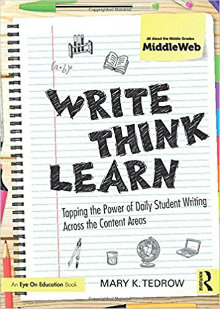Tapping the Power of Daily Student Writing
Write Think Learn: Tapping the Power of Daily Student Writing Across the Content Areas
By Mary K. Tedrow
(Routledge/MiddleWeb, 2018 – Learn more)

After reading this book, if you’re not asking your students to do low-stakes daily writing that brings thinking to the forefront, it may be hard to justify to yourself why not.
Mary K. Tedrow’s Write Think Learn: Tapping the Power of Daily Student Writing Across the Content Areas makes a strong case for consistent written idea generation, not only in the English classroom but in all content areas.
Tedrow’s background as a leader in the National Writing Project informs every page, and the book ranges wide and deep. I appreciated her classroom stories as well as her synthesis of several decades of research in the field.

Many times I found myself starring ideas I wanted to try out. Some were as straightforward as a well-worded synthesis question: “What stands out to me after everything I’ve learned?” Others were as complex as “Cubing to Find Insight,” a process in which students take six different perspectives on a topic they are researching: describing, comparing, association, analyzing, applying and arguing.
So how does Tedrow encourage her students to write every day and to take that writing to heart?
At the beginning of each year, she asks her students to set up a Daybook, a term she took from English teacher/guru Donald Murray: “As Murray argued, any writing will lead to the discovery of new thinking. The writing itself engenders thought.”
Tedrow’s excellent bibliography inspired me to read Natalie Goldberg’s Writing Down the Bones concurrently with this book. If you’ve read Goldberg’s classic work, you’ll see many commonalities between her idea of daily “writing practice” and the Daybook.
More about what’s inside
Tedrow’s first chapters offer enough detail about setting up the Daybook (including potential stumbling blocks) to implement it with students like an expert.
Kids establish a habit through twenty-one days of writing, in a physical, personalized notebook that, in Tedrow’s words, “must make you want to write!” They add complexity with a mission statement for themselves as writers and an index page that lets them track their trains of thought.
This index leads naturally to larger pieces of writing later on: “Students can reread passages and characterize them later, either on their own or at the teacher’s direction. For example, a teacher might ask students to create an index item called ‘Causes of the Civil War’ and have students collect all page numbers for entries which fall under this category.” As a middle school history teacher, I loved this idea that inspires both organization and synthesis at once.
All kinds of writing
One message I took away is that daily practice can ground students not simply for creative but also for analytical writing.
In a section titled “Looking at Theory: What to Expect in Student Response,” Tedrow observes: “Prompting this kind of writing, writing which students always characterize as ‘easy,’ helps students process learning while permitting a wrestling with ideas at a very individual level. After seeing what they know, students more easily transform what is said informally into either informational texts, like reports or essays… or into an artistic form like a narrative or poem.”
In addition, Tedrow insists that we are being unrealistic when we ask students to transfer their writing knowledge from one discipline to another. She argues convincingly that “every writing task is a new problem in thinking but the skills practiced in English will not naturally be transferred into another course” and “everyone writes poorly when they do not know what they are writing about.” This observation made me want to revisit, once again, how the writing skills I want my students to show in history are similar to and different from those they demonstrate in English.
Thoughts about grading
Tedrow warns against moving to formal writing or summative assessments too soon. The last chapter offers rescue for English or history teachers, asking: “What About Grading?” Her advice is excellent: “delay grading for as long as possible so that the learning drives the work, and bring students in on the evaluation wherever possible so discussions of quality and achievement – and how to get there – are not a secret.”
Tedrow also notes that “Grading has the effect of ending practice,” another way of encouraging us to focus more on daily formative assessments than end-of-unit summative assessments. This chapter also includes many practical tips for grading the actual Daybook, with the understanding that teachers will not grade close to every entry, and that this practice benefits everyone! The more responsibility we give to students, the more they will rise to the occasion.
A positive classroom culture
Throughout the book, I appreciated Tedrow’s tone. I felt she was supporting my work as a teacher – and, by extension, my students – with the encouraging language she uses.
At one point, Tedrow describes a “Let’s see what you are doing right” classroom culture, in which students feel comfortable writing and sharing. This phrase could be a mantra for her teaching philosophy as expressed in this book, and it’s an approach that could make you want to write as much as your students.
Sarah Cooper teaches eighth-grade U.S. history and is dean of studies at Flintridge Preparatory School in La Canada, California, where she has also taught English Language Arts. She is the author of Making History Mine (Stenhouse, 2009) and Creating Citizens: Teaching Civics and Current Events in the History Classroom (Routledge/MiddleWeb, 2017). She presents at conferences and writes for a variety of educational sites. You can find all of Sarah’s writing at sarahjcooper.com.




































Sarah, I love the idea of a “Daybook” and writing for 21 days. In addition, I have found to be true, “everyone writes poorly when they do not know what they are writing about.” I will definitely find and read this book! Thank you.
Mary, I think you will love it! This book, along with Writing Down the Bones, inspired me to start my own daily writing for the past two weeks.